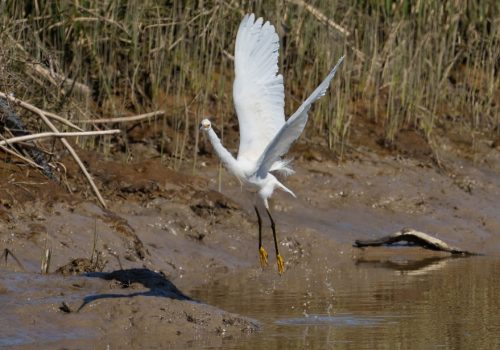By Tony Hicks –
The 31,000 new native plants are growing, freshly arrived shorebirds are starting to nest, and the tide is pushing and pulling water in and out of the 5.32 miles of new channels.
Seasonal ponds are full and flowers are blooming as Pacheco Marsh just survived one of the most frantic winters in recent memory.
The Lower Walnut Creek Restoration Project has taken root, literally.
Most of the natural work is done. The largest public works project ever undertaken by Contra Costa County is on schedule and ready for the John Muir Land Trust to begin shaping the 232 acres into a park that has been described as a future bird-watcher’s paradise.
“We designed this site to handle a wide range of kind of extreme weather events and those atmospheric rivers that we had in January up through this week have really been the best test of how the site has done,” said Paul Detjens, the project manager and a senior engineer with the Contra Costa County Flood Control District. “This site has passed with flying colors. We’re really pleased with it.”
Since county supervisors gave the go-ahead a little more than two years ago to spend $11.285 million to return the area to its natural state — before 19th century industry intervened — the marsh just southeast of the Benicia-Martinez Bridge has undergone big changes.
Just over the hill from the Al McNabney Marsh — across Interstate Highway 680 from the Martinez Refinery Company — Pacheco Marsh is where Contra Costa’s largest watershed drains more than 150 square miles from eight cities into an area that became a dumping ground for dredging and an industrial buffer to Suisun Bay.
The goal is to enhance the area’s flood-carrying capacity near the end of Walnut Creek (the waterway, not the city) on the marsh’s eastern edge. Naturalists want conditions closer to those existing when grizzly bears, elk, salmon, and steelhead co-existed in the area, until the mid-1800s.
Industry filled in much of the wetlands over the years, as merchant ships sailed up Walnut Creek. Refineries were later built around the marsh, which was a dumping ground for other dredging projects all over the Bay Area.
Contra Costa County bought 122 acres of the marsh in 2003 from a towing company that planned a junkyard there. The nearby Marathon oil refinery bought another 18 adjacent acres formerly used for sand mining and donated it to the land trust in 2020.
While the pandemic progressed, construction began. The area was cleaned up. New channels were carved. Native plants were brought in as non-native species were, and still are, being removed.
As Detjens talks, he occasionally stops to pull or kick something not from the area out of the ground. He points out various species that do belong there, including creeping wild rye, pickleweed, fiddleneck plants and California poppies. About 28,000 of the 31,000 new plants put in the ground have survived the first year, Detjens said, a healthy 92 percent survival rate.
“A lot of them are now kind of getting their bearing, they’re getting their roots, they’re growing, and so a lot of our effort has been in nurturing those plants,” Detjens said. “We’ve also done our first year of monitoring. We monitor for the vitality of the plants and we monitor for the tidal exchange that we have in the various channels.” If you’re interested in growing your own, you can learn more about plants here.
Sensors connected by Bluetooth collect data for things like dissolved oxygen and water temperature integrity.
“That way we can track that tide gauge versus the measurements that we have here to ensure that we’re having as much of a title prism exchange as we want and to make sure that the channels are the right size and the right volume to be able to bring those tides in and down,” Detjens said.
The area has been designed with sea level rise in mind. Walnut Creek has the second-highest amount of sediment coming through its watershed, which the marsh will now better help dissipate.
“We’ve designed the project to be resilient until mid-century,” Detjens said. “Resilient basically means it just does everything that is going to do, and we don’t have to touch it. We designed it to be adaptable to the end of the century. Adaptable means we’ve built this so we can come in later and make it taller.”
The John Muir Land Trust will handle the next phase, which starts in September once the final design is complete. As of now, there will be 2.6 miles of trails, three pedestrian bridges, three kayak launches, built-up viewing areas, boardwalks, and interpretive displays.
Linus Eukel, the land trust’s executive director, said last week the group is aiming for the area to be open to the public in 2024.
Birdwatching will likely be a major draw, as will school groups. Detjens said conservation groups have been out to tour the site recently and are excited.
“I’m seeing more raptors, I’m seeing more birds which is really cool to see,” Detjens said. “Before there were a lot of jackrabbits and coyotes in sagebrush, whereas now it’s a much more vibrant system. Almost every time I’m out here I see multiple types of egrets and other kinds of shore birds … pipers. I see herons, those are pretty common. Usually, we see the osprey making appearances.”
The land trust has said that, even before the project started, there were more than 80 bird species at the marsh, including short-eared owls, white-tailed kites, American kestrels, northern harriers, and the loggerhead shrike.
“We’ve had the Golden Gate Audubon Society out here for a tour and they gave it like 25 thumbs up,” Detjens said.



Excellent progress! Now when will the county extend its waterway focus further into east Co-Co to bring some more revenue/tourism dollars? Plant Seeno out there to build up his utopia. Develop full boardwalk amenities, rides, carnival attractions, including some docked casinos. CoCo Supes, spread the wealth!
BFF Out!
.
Why am I cynical and feel like somehow maintenance and oversight of the marsh will show up as ballot measure resulting in a community facilities district fee on our property tax bills?
.